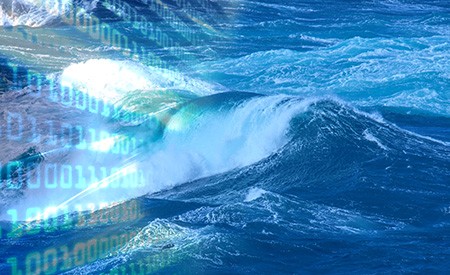/H2020/DTOCEANPLUS
Type of resources
Available actions
Topics
Keywords
Contact for the resource
Provided by
Formats
status
-

This document summarises both the functionalities as well as the more technical aspects of the code implemented for this module. This module will provide the user with four assessments: identification of the potential presence of endangered species in the area; environmental impacts estimated using relevant metrics such as the underwater noise or the collision risk between vessels/devices and the marine wildlife; estimation of the carbon footprint of the project in terms of two mid-point indicators; information to improve the social acceptance of the project considering cost of consenting and jobs creation.
-

This report collates the materials used throughout the DTOceanPlus project on knowledge exchange and training.
-

This document serves as the technical manual of the alpha version of the system performance and energy yield module, including all the data requirements, main functions, interfaces and all the pertinent technical details.
-

Cost reductions in nascent forms of Renewable Energy Technology (RET) are essential for them to contribute to the energy mix. Policy intervention can facilitate this cost reduction; however, this may require a significant investment from the public sector. These cost reductions fall into two broad categories: (1) incremental cost reductions through continual improvements to existing technologies, and (2) radical innovation where technologies that significantly differ from the incumbents are developed. This study presents a modelling methodology to integrate radical innovation in RET experience curve and learning investment analysis, using wave energy as an example nascent RET. This aims to quantify the potential effects of radical innovation on the learning investment, allowing the value of successful innovation to be better analysed. The study highlights the value offered by radical innovations in long-term deployment scenarios for wave energy. This suggests that high-risk R&D efforts in nascent RET sectors, even with low success rates, could still present significant expected value in offsetting future revenue support.
-

This report describes the methodology used to define the “validation scenarios”, accounting for the different potential use cases. Given the large number of permutations of tools, use cases, and the set of minimum validation requirements, the number of validation scenarios has been reduced to a number that can be run during the life of the DTOceanPlus project but that are sufficient to fully demonstrate the functionality of the DTOceanPlus suite of tools. The selection process, based on a successive approximation approach, has led to the cases that the potential users in the DTOceanPlus consortium have considered as the most relevant for the sector. In Section 4 of the document, the selected validation scenarios is described; the definition of these scenarios has been completed during the project to ensure that the most updated information is used.
-

A coherent set of functional and technical requirements have been developed for the DTOceanPlus suite of design tools based on analysis of gaps between the current state-of-the-art tools, learning from the original DTOcean project, and the stakeholder expectations identified in the user consultation survey. The technical requirements in this document are translated from the general requirements for the overall suite of tools, and specific requirements (functional, operational, user, interfacing, and data) for the Structured Innovation design tool that has been developed as part of this project. These requirements relate to detailed technical requirements of the technology and environment, for the development, maintenance, support and execution of the software specifications to best meet the needs of the ocean energy industry.
-

Ocean energy is a relevant source of clean renewable energy, and as it is still facing challenges related to its above grid-parity costs, tariffs intended to support in a structured and coherent way are of great relevance and potential impact. The logistics and marine operations required for installing and maintaining these systems are major cost drivers of marine renewable energy projects. Planning the logistics of marine energy projects is a highly complex and intertwined process, and to date, limited advances have been made in the development of decision support tools suitable for ocean energy farm design. The present paper describes the methodology of a novel, opensource, logistic and marine operation planning tool, integrated within DTOceanPlus suite of design tools, and responsible for producing logistic solutions comprised of optimal selections of vessels, port terminals, equipment, as well as operation plans, for ocean energy projects. Infrastructure selection logistic functions were developed to select vessels, ports, and equipment for specific projects. A statistical weather window model was developed to estimate operation delays due to weather. A vessel charter rate modeling approach, based on an in-house vessel database and industry experience, is described in detail. The overall operation assumptions and underlying operating principles of the statistical weather window model, maritime infrastructure selection algorithms, and cost modeling strategies are presented. Tests performed for a case study based a theoretical floating wave energy converter produced results in good agreement with reality.
-

The present document refines the previous version submitted in October 2019, updates the initial assumptions, and depicts more clearly the exploitation routes and actions to reduce risks.
-

This report provides a critical evaluation of the ocean energy sector’s legal, institutional, and political frameworks with an identification and analysis of barriers and enabling factors for the deployment of ocean energy.
-

The Structured Innovation (SI) design tool comprises innovation methodologies that can enhance concept creation and selection in ocean energy systems, enabling a structured approach to address complex ocean energy engineering challenges where design options are numerous. Thus, it can facilitate efficient evolution from concept to commercialisation. The tool is one of a kind beyond the current state-of-the-art, that will enable the transfer and adaptation of the QFD/TRIZ and FMEA methodologies to the ocean energy sector.
 Catalogue PIGMA
Catalogue PIGMA